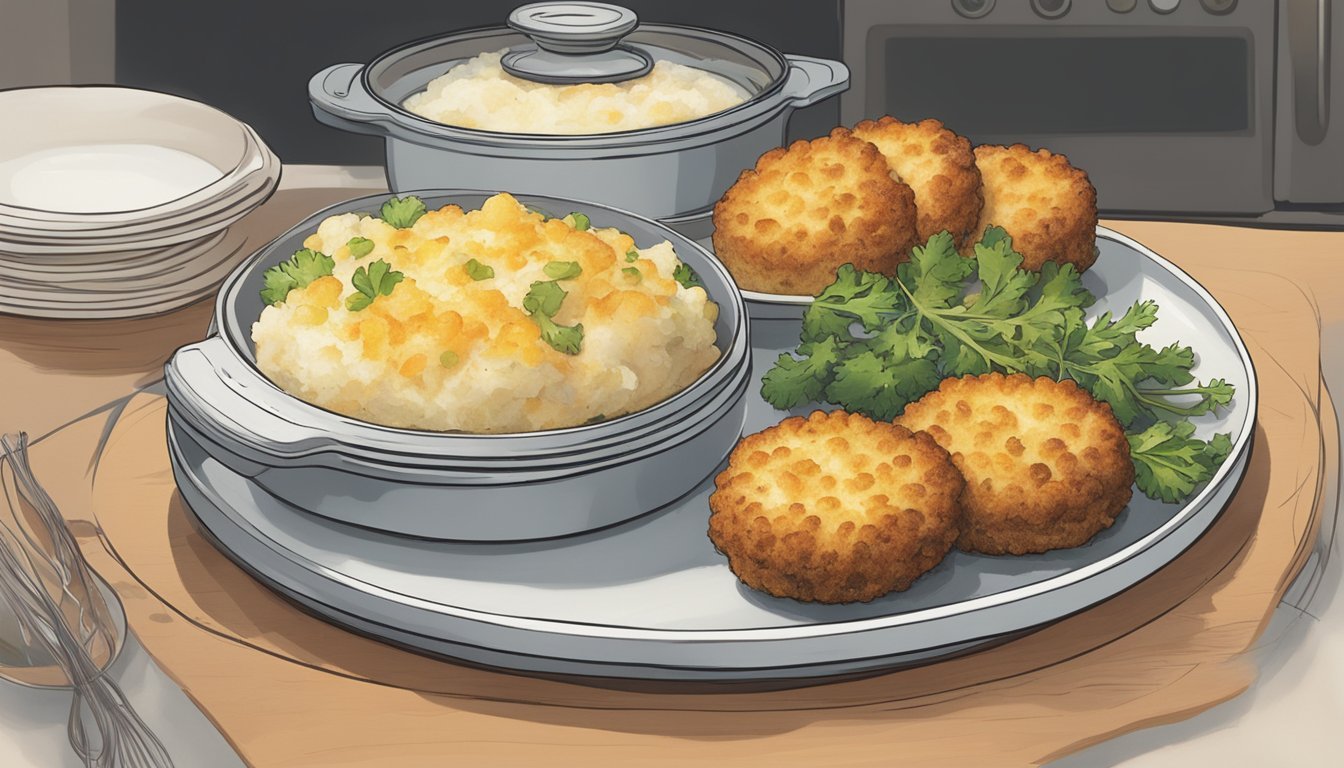Best Way to Reheat Cod Cakes
Ensuring Optimal Crispiness and Tenderness
Reheating cod cakes is a culinary challenge many home cooks face when looking to enjoy leftovers without sacrificing the quality of the dish. Cod cakes, treasured for their delicate balance between a crispy exterior and a tender, flavorsome interior, require careful reheating to maintain their integrity. Ensuring these savory treats retain their desired texture and flavor when reheated calls for specific techniques that go beyond simply warming them up.
Whether using an oven or alternative methods, the key to successfully warming up leftover cod cakes lies in mimicking the cooking process that originally gave them their crispiness and moisture. It’s not just a matter of reheating; it’s about revitalizing the essence of the cod cake's delectable appeal. With an emphasis on temperature control, coverage, and timing, it's possible to bring back the freshness and satisfying mouthfeel of the original meal.
Understanding Cod Cakes
Cod cakes are a beloved dish for their harmonious blend of flavors and textures. They present a dining experience that is both satisfying and delicate, often requiring careful reheating to maintain their quality.
Composition of Cod Cakes
Cod cakes are mainly composed of cod fish, a white, flaky, and mild-tasting fish that serves as the primary protein. The fish is usually combined with binding ingredients such as eggs and breadcrumbs to create a firm yet tender texture upon cooking. Seasonings and herbs are added to enhance the flavor, offering a palatable balance that complements the natural taste of the cod. The outer layer of each cake is often coated with more breadcrumbs to achieve a crispiness when fried or baked.
Reasons for Reheating
Reheating cod cakes is usually necessary when they are consumed after initial preparation. Whether they're leftovers or prepared in advance, reheating is crucial for bringing back the desirable texture and warmth. The process must ensure that the cod cakes are heated to a safe internal temperature for food safety, without compromising on their crispiness or flavor.
Preparation for Reheating
Properly preparing cod cakes for reheating is crucial for preserving their crispiness and tenderness. These steps ensure a balance of texture and flavor once reheated.
Thawing Frozen Cod Cakes
If cod cakes are stored in the freezer, they should be thawed completely before reheating to maintain their quality. It is recommended to transfer the frozen cod cakes to the refrigerator and allow them to thaw overnight. The gradual temperature increase helps in preserving the cod cakes' structure and moisture.
Thawing Method:
Move cod cakes from freezer to refrigerator.
Allow to thaw overnight or for at least 12 hours.
Bringing to Room Temperature
Before reheating, one should let the cod cakes come to room temperature. Taking them out of the refrigerator 15-20 minutes before reheating can prevent the exterior from cooking too quickly while the inside remains cold. This step also minimizes the risk of drying out the cod cakes during the reheating process.
Method to Bring to Room Temperature:
Place cod cakes on a plate lined with a paper towel.
Leave at room temperature for 15-20 minutes.
By following these methods, one can create favorable conditions for achieving optimal texture when the cod cakes are reheated.
Reheating Methods Overview
The key to successfully reheating cod cakes lies in preserving their crisp exterior and tender interior. The method chosen can make a significant difference in texture and moisture retention.
Oven Reheating
To reheat cod cakes in the oven, preheat it to 350°F (175°C). It is important to line a tray with foil or parchment paper to prevent sticking. Cod cakes should be placed on the tray, covered loosely with foil to keep them moist. They should then be heated for 15-20 minutes.
Skillet Reheating
Reheating in a skillet requires a bit of oil to maintain crispiness. Heat a pan over a medium flame and add a thin layer of oil. Once hot, add the cod cakes, cooking for about 3-4 minutes on each side until they are heated through and crispy on the outside.
Microwave Reheating
Microwaving is the quickest method but can make the cod cakes soft. To mitigate this, place the cod cakes on a microwave-safe dish, and cover with a damp paper towel. Heat on medium power for short bursts of 30-60 seconds, checking frequently to avoid overcooking.
Air Fryer Reheating
An air fryer can beautifully reheat cod cakes while keeping them crisp. Preheat the air fryer to 350°F. Arrange the cod cakes in the fryer's basket, ensuring they're not touching. Reheat for about 3-5 minutes, or until thoroughly warmed and crispy. No oil is required since circulating hot air will crisp up the exterior.
Oven Method
Reheating cod cakes in the oven is an excellent way to maintain their crisp exterior while ensuring the inside stays tender and moist. This method circulates dry heat around the cod cakes, achieving an even warm temperature without making them soggy.
Preheating and Equipment
The initial step is to preheat the oven. One should set the temperature to 350°F (175°C) to prepare the oven. During the preheating time, they can gather the necessary equipment. Using a baking sheet is preferable, and it is advised to line it with parchment paper to prevent the cod cakes from sticking to the surface. Alternatively, one may use aluminum foil if parchment paper is not on hand. If using aluminum foil, it may be beneficial to lightly grease the surface to ensure easy removal of the cod cakes after reheating.
Step-by-Step Oven Reheating
Once the oven reaches the required temperature, the actual reheating process can begin. Here's a simplified step-by-step guide:
Remove the cod cakes from the refrigerator and let them sit at room temperature for a few minutes, which will promote even reheating.
Place the cod cakes on the prepared baking sheet, ensuring they are not touching to allow heat to circulate properly.
If desired, loosely cover the cod cakes with aluminum foil. This will help retain moisture in the cakes.
Place the baking sheet in the center of the oven. This positioning allows for the most efficient heat distribution.
Heat the cod cakes for about 10 to 15 minutes. The exact time will depend on the size and thickness of the cod cakes.
It's crucial that one checks the cod cakes periodically to ensure they are heated through to the desired temperature without overcooking.
Skillet Method
Reheating cod cakes in a skillet can achieve a delightful balance between crisp exteriors and moist interiors. Mastery of this technique requires careful attention to the type of oil used and the application of controlled heat.
Oil Selection
When selecting an oil for skillet reheating, one should opt for oils with a higher smoke point to avoid burning. Olive oil, especially extra virgin olive oil, is a popular choice that adds a slight flavor and can tolerate moderate temperatures.
Olive oil: Best for flavor, moderate heat
Canola oil: A neutral taste, high smoke point
Butter: Adds richness, but be mindful of lower smoke point and potential to burn
Skillet Reheating Technique
To reheat properly in a skillet, one must:
Preheat the skillet over medium heat. A non-stick skillet is recommended to reduce the risk of the cod cakes sticking and breaking apart.
Add oil: Pour a thin layer of the chosen oil or add a small pat of butter to the skillet.
Place cod cakes: Gently lay the cod cakes in the skillet once the oil shimmers, indicating it's adequately heated.
Heat thoroughly: Allow them to cook for about 3-4 minutes on one side. Then, carefully flip to ensure an even heat distribution without overcooking. Overcooking can toughen the cod cakes, sacrificing tenderness.
Note: Each side should develop a golden brown hue which signals a crispy exterior.
Employing this skillet method combines one's culinary prowess with a touch of patience, resulting in cod cakes that are rejuvenated in both taste and texture.
Microwave Method
When reheating cod cakes in a microwave, the aim is to preserve their moisture and tenderness while avoiding the rubbery texture often associated with microwaved fish.
Using Microwave Safely
To reheat cod cakes safely in a microwave, they should be placed on a microwave-safe plate. They must be covered with a damp paper towel to ensure the fish retains moisture during the reheating process. It’s also important to use a microwave-safe cover or a lid with vents to allow steam to escape, as this helps maintain the desired texture.
Plate preparation: Microwave-safe plate, covered with a damp paper towel.
Covering: Use a microwave-safe cover or vented lid to prevent splattering and preserve texture.
Avoiding Rubberiness
To avoid a rubbery texture when reheating cod cakes, microwave them at a medium power level (about 50% power), which heats the fish more gently and evenly. It's crucial not to overcook the cod cakes, as this is a common cause of rubberiness.
Set microwave power to 50%.
Reheat in short intervals, checking frequently for even warmth.
Using this method helps ensure that your cod cakes will be warmed through while maintaining their desirable tenderness and moisture levels.
Air Fryer Technique
Using an air fryer to reheat cod cakes offers a balance between crispiness and tenderness. This method ensures the exterior becomes crispy, while the interior remains moist.
Settings and Precautions
When preparing to reheat cod cakes in an air fryer, it's crucial to adjust the settings appropriately to avoid overcooking.
Preheat the air fryer to a temperature of 350°F (175°C), creating an ideal cooking environment.
Avoid overcrowding the basket to ensure even air circulation for uniform crispiness.
To prevent sticking, one can lightly oil the basket or use parchment paper with holes.
Reheating in Air Fryer
Cod cakes should be reheated with care to maintain their quality.
Place the cod cakes in a single layer in the air fryer basket; they should not touch to provide even heating and crispiness.
Cook for about 3-5 minutes. The exact time may vary based on the air fryer's model and the size of the cod cakes.
Halfway through, it is advisable to check them and flip if necessary, to ensure they are heated evenly without losing moisture.
Tips for Success
The key to reheating cod cakes effectively is to maintain their moisture while restoring their crisp outer texture. By steering clear of common reheating mistakes and employing techniques to enhance crispiness and flavor, one can enjoy cod cakes that are nearly as pleasing as when they were first made.
Avoiding Common Mistakes
Overheating: One should avoid overcooking the cod cakes as it may lead to them becoming dry. They should warm through to the center without the edges becoming too hard.
Microwaving: Microwaving is not recommended for reheating cod cakes since it could make them soggy. Consistent oven heat is the best approach to ensure even reheating.
Enhancing Crispiness and Flavor
Oven Temperature: Preheat the oven to a moderate temperature, around 350°F (175°C), which will warm the cakes thoroughly without burning the exterior.
Baking Sheet Preparation: Line a baking sheet with parchment paper or lightly grease it to prevent sticking, and arrange the cod cakes evenly to allow for air circulation.
Moisture Retention:
A light brushing of oil or a small drizzle of lemon juice before reheating can help to retain moisture and add flavor.
Cover the cod cakes loosely with foil to trap some moisture during the heating process.
Spices: Adding a sprinkle of fresh spices or herbs after reheating can refresh the flavor profile of the cod cakes.
By following these specific guidelines, one can reheat cod cakes to a condition that rivals their initial texture and taste.
Serving and Accompaniments
When serving cod cakes, choosing the right sides and sauces can elevate the dish, ensuring a balance between crispiness and tenderness. The presentation of the cod cakes also plays a significant role in enhancing the dining experience.
Sides and Sauces
For the sides:
Salads: A light and crisp salad, such as a mixed green or arugula salad, complements the richness of the cod cakes. The freshness of the greens contrasts nicely with the savory flavors.
Vegetables: Steamed or roasted vegetables like asparagus or green beans add color and nutrition to the plate without overpowering the main dish.
In terms of sauces:
Tartar Sauce: The tangy flavor of tartar sauce is a classic pairing with seafood, especially cod cakes. Its creamy texture and pickled components add depth.
Lemon Juice: A squeeze of fresh lemon juice over the cod cakes can provide a bright burst of acidity that enhances the fish's delicate flavor.
Presentation Tips
Plating: Serve the cod cakes on a warm plate to maintain temperature. Place them centrally with the accompaniments arranged neatly around them for visual appeal.
Garnishing: A sprinkle of freshly chopped parsley or dill over the cod cakes can introduce a subtle herbaceous note and a touch of color.
Storing Leftover Cod Cakes
Proper storage of leftover cod cakes is essential to maintain their quality. They should be stored in ways that prevent bacteria growth and freezer burn, ensuring they remain safe and delicious for later consumption.
Refrigeration Best Practices
To refrigerate leftover cod cakes, they should be allowed to cool to room temperature before storage to minimize bacterial growth. Leftovers should be wrapped tightly in aluminum foil or placed in an airtight container to maintain moisture and freshness. Refrigeration is suitable for short-term storage of up to two days.
Cool down: Allow cakes to reach room temperature.
Wrap securely: Use foil or an airtight container.
Refrigerate: Store below 40°F (4°C).
Freezing and Defrosting
For longer storage, freezing leftover cod cakes is advisable. Each cod cake should be wrapped individually with foil to protect against freezer burn, then placed in a freezer-safe container or bag. Clearly label with the freezing date. To defrost, it's best to thaw the cod cakes in the refrigerator overnight.
Individual wrapping: Prevents freezer burn and sticking.
Freezer-safe container: Shields from odors and contamination.
Labeling: Mark the date for quality tracking.
Thawing: Defrost in the refrigerator, not at room temperature.
When handling leftovers, always ensure cleanliness to further inhibit bacterial contamination.
Maintaining Quality and Safety
When reheating cod cakes, it's crucial to balance maintaining their quality – retaining crispiness and tenderness – with food safety standards, such as proper temperature control to prevent bacterial growth.
Cod Cake Freshness
To ensure the best quality, cod cakes should be stored in a refrigerator at a temperature below 40°F (4°C) immediately after cooling. They should be consumed within 1-2 days to maintain their texture and flavor. For reheating, an oven preheated to 350°F (175°C) is optimal to restore the cakes' crisp edges without drying them out. Each cake should be reheated until it reaches an internal temperature of 145°F (63°C), the point at which they're warmed sufficiently while preserving moisture.
Health Considerations
Adhering to safe reheating practices is essential to reduce the risk of foodborne illnesses. Cod cakes should reach an internal temperature of at least 145°F (63°C) to effectively eliminate any potential bacteria. It’s advisable to use a food thermometer to verify this. If cod cakes were left at room temperature for more than 2 hours, it's safer to discard them to avoid the risk of bacterial contamination, as bacteria can multiply rapidly at temperatures between 40°F - 140°F (4°C - 60°C).






